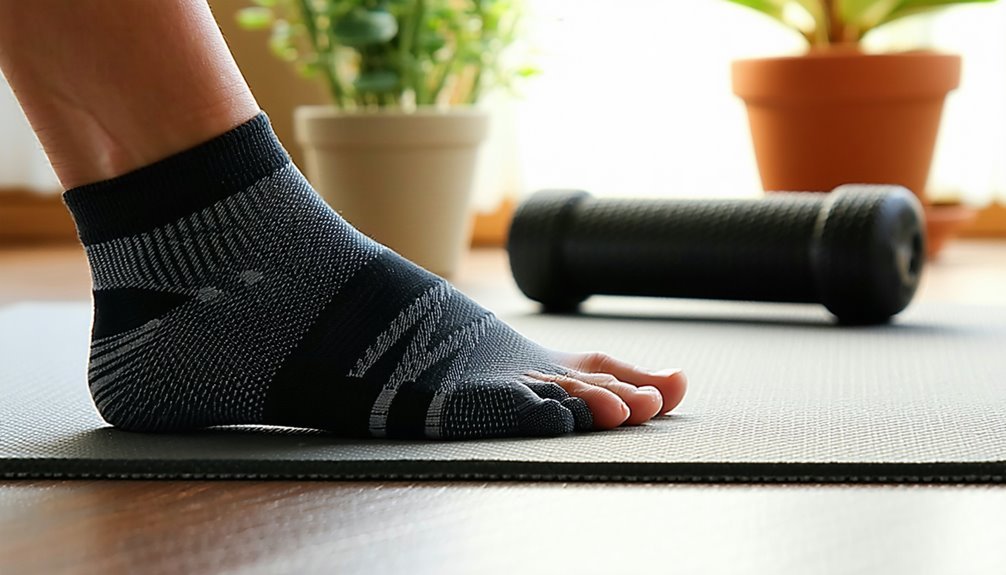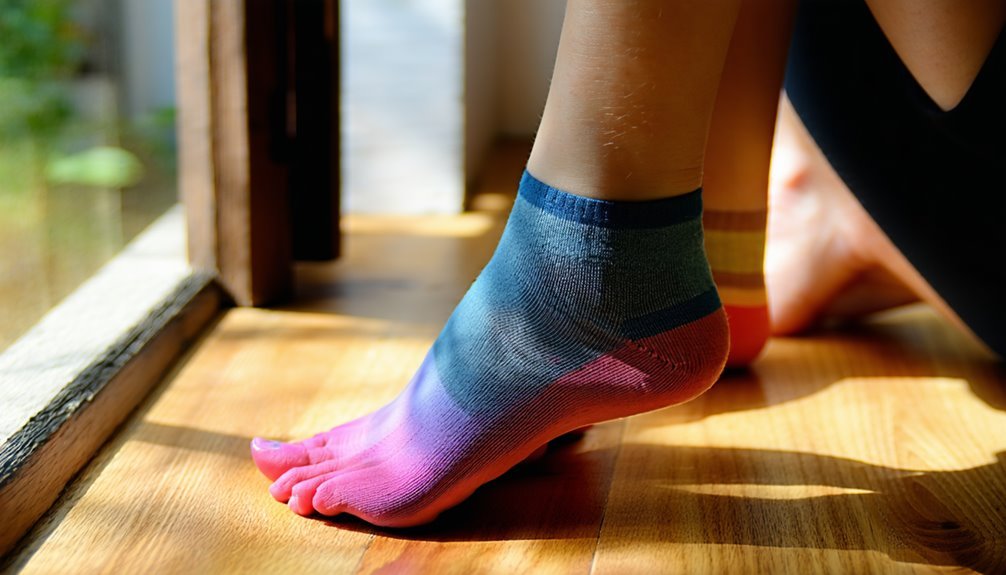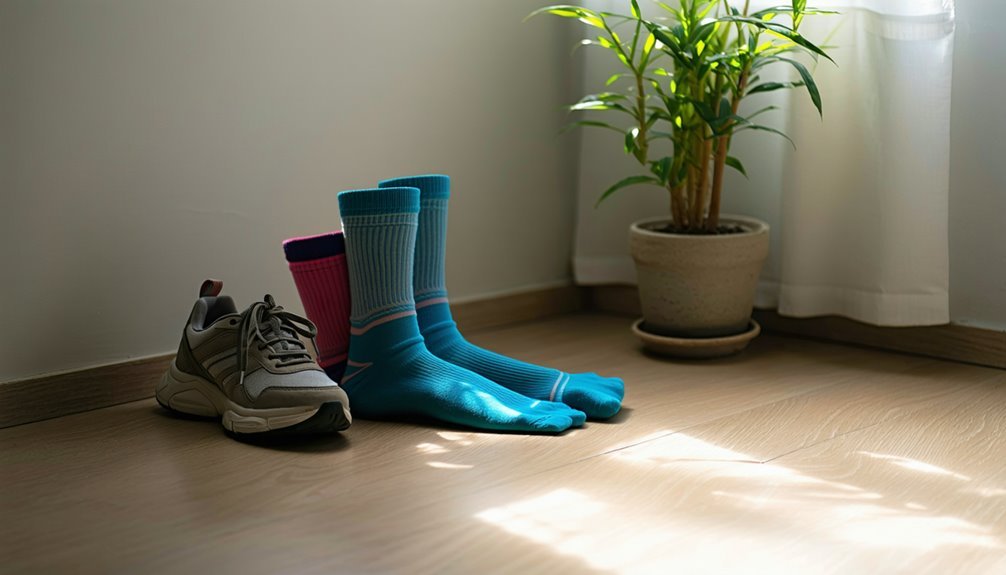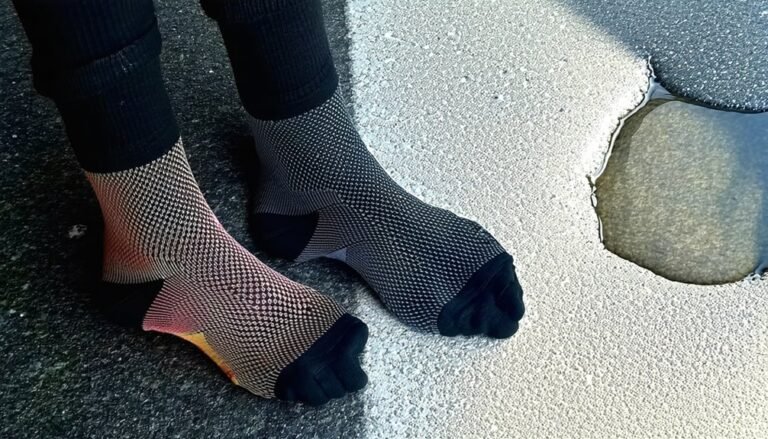Can Compression Socks Help Plantar Fasciitis?
Compression socks can considerably ease plantar fasciitis symptoms by improving blood circulation and reducing inflammation in the feet. The graduated pressure they provide supports the arch and heel, helping to stabilize foot mechanics and reduce strain on the plantar fascia. Choosing the right fit and compression level enhances comfort and effectiveness, promoting quicker recovery and diminished pain. Explore how integrating these socks with other treatments can further enhance plantar fasciitis management for ideal relief.
Understanding Plantar Fasciitis

When you first experience the sharp heel pain characteristic of plantar fasciitis, it can be both alarming and debilitating. This condition arises from inflammation of the plantar fascia, a thick band of tissue connecting your heel bone to your toes. Understanding plantar fasciitis causes is essential for effective management. Common causes include repetitive strain from activities like running, prolonged standing, or wearing inadequate footwear. Additionally, factors such as obesity, age, and foot mechanics can contribute to this condition. The plantar fasciitis symptoms typically manifest as stabbing pain, primarily occurring during your first steps in the morning or after periods of inactivity. Recognizing these symptoms early can help you take the necessary steps to address and mitigate potential complications.
The Role of Compression Socks
Although managing plantar fasciitis can be challenging, compression socks offer a promising approach to alleviate symptoms. The compression benefits include enhancing circulation and reducing swelling, potentially accelerating recovery. By applying graduated pressure, these socks can mitigate inflammation, a common complication in plantar fasciitis. It's vital to choose the right sock styles to guarantee peak support and comfort. Various styles are available, such as toeless or full-foot designs, each catering to different needs. For instance, toeless styles might offer increased breathability, while full-foot versions provide extensive coverage. When selecting compression socks, consider the level of compression, typically measured in millimeters of mercury (mmHg), to ensure safety and effectiveness. Proper selection promotes comfort and enhances foot health, aiding in symptom management.
How Compression Socks Work
By wearing compression socks, you're enhancing blood circulation, which is essential for delivering oxygen and nutrients to the tissues affected by plantar fasciitis. These socks apply consistent pressure to reduce swelling and inflammation, key contributors to the pain you experience. Additionally, they provide targeted support to your arch and heel, aiding in stabilizing the foot and minimizing strain.
Improve Blood Circulation
Understanding how compression socks improve blood circulation can enhance your approach to managing plantar fasciitis. By applying graduated pressure, these socks support your veins in efficiently returning blood to the heart, thereby promoting ideal blood flow. This mechanism is vital because enhanced circulation improvement reduces the risk of pooling blood and associated discomfort in your lower extremities. When you wear compression socks, they're designed to be tighter at the ankle and gradually loosen up the leg. This gradient compression aids in improving venous return, which is essential for maintaining healthy feet and mitigating pain associated with plantar fasciitis. Trust in the evidence-based benefits of these socks to guarantee your safety and well-being while seeking relief from persistent foot pain.
Reduce Swelling and Inflammation
When dealing with plantar fasciitis, you'll find that compression socks are an effective tool for reducing swelling and inflammation, vital for alleviating pain. These socks apply consistent pressure, fostering enhanced venous return and promoting efficient lymphatic drainage. This mechanism guarantees that excess fluid is minimized in affected tissues, leading to noticeable swelling reduction. Compression socks also contribute to inflammation control by stabilizing soft tissues and minimizing micro-tears.
| Benefit | Explanation |
|---|---|
| Swelling Reduction | Encourages fluid movement, reducing tissue fluid. |
| Inflammation Control | Stabilizes tissues, preventing further irritation. |
| Pain Alleviation | Mitigates symptoms by reducing internal pressure. |
| Enhanced Recovery | Promotes healing by improving blood flow. |
Support Arch and Heel
As you explore the benefits of compression socks in reducing swelling and inflammation, it's important to understand how they also support the arch and heel, which is integral for those suffering from plantar fasciitis. These socks are designed to provide targeted arch support, helping maintain the foot's natural alignment. By enhancing heel stability, they can reduce strain on the plantar fascia, the ligament causing discomfort. Compression socks apply consistent pressure, promoting proper blood circulation, essential for tissue repair. This pressure aids in the stabilization of the foot's structure, minimizing excessive movement that could exacerbate symptoms. Choosing socks with adequate arch support and heel stability guarantees not only comfort but also a significant reduction in pain and risk of further injury.
Potential Benefits for Heel Pain

Plantar fasciitis can be a persistent source of heel pain, but compression socks may offer a beneficial intervention. By providing targeted support, these socks can enhance your pain management strategy and complement footwear recommendations. Their design promotes blood flow, which may reduce inflammation and alleviate discomfort. Here are some potential benefits:
- Pain Relief: Compression socks apply consistent pressure, which can mitigate heel pain by reducing tension on the plantar fascia.
- Improved Circulation: Enhanced blood flow aids in the healing process, potentially shortening recovery time.
- Support and Stability: They provide additional support to the arch and heel, fostering stability during daily activities.
- Reduction in Swelling: By minimizing fluid buildup, compression socks can decrease swelling, contributing to overall comfort and safety.
Evidence From Scientific Studies
Numerous studies have investigated the efficacy of compression socks for alleviating symptoms of plantar fasciitis. You'll find that compression therapy is backed by scientific evidence supporting its role in reducing heel pain and improving foot function. Some studies highlight how graduated compression helps improve blood circulation, promoting healing and reducing inflammation. Others suggest that consistent use can lead to a significant decrease in morning heel pain, a common complaint among those with plantar fasciitis.
It's important to note that while scientific evidence points to potential benefits, individual responses may vary. Consulting with healthcare professionals guarantees that this therapeutic option aligns with your specific needs. Always prioritize safety and guarantee that compression therapy is part of an all-encompassing treatment plan tailored for you.
Choosing the Right Compression Socks
When selecting compression socks for plantar fasciitis, you'll want to take into account the material and fabric type, as these factors can affect both comfort and effectiveness. Evidence suggests that materials like nylon and spandex offer ideal elasticity and moisture-wicking properties, which are essential for maintaining foot health. Additionally, choosing the right compression level, typically ranging from 15-30 mmHg, can greatly impact your symptom relief and overall comfort.
Material and Fabric Type
Selecting the appropriate material and fabric type for compression socks is vital in managing plantar fasciitis effectively. Proper choice guarantees ideal support and comfort, reducing strain on the plantar fascia. Here are important factors you should consider:
- Fabric Breathability: Opt for materials like merino wool or synthetic blends that promote air circulation, keeping your feet dry and reducing irritation.
- Material Durability: Choose fabrics that withstand wear and tear, such as nylon or spandex, guaranteeing long-lasting effectiveness.
- Moisture-Wicking Properties: This feature prevents sweat accumulation, reducing the risk of fungal infections and enhancing foot hygiene.
- Seamless Design: Look for socks with a seamless construction to minimize friction and prevent blisters, offering a safer and more comfortable experience.
Selecting the right compression socks boosts your plantar fasciitis management strategy efficiently.
Compression Level Options
After contemplating the fabric type, it's crucial to understand the importance of compression level in sock selection for plantar fasciitis management. Compression levels, measured in millimeters of mercury (mmHg), range from mild (15-20 mmHg) to moderate (20-30 mmHg) and firm (30-40 mmHg). When choosing sock types, you'll want to reflect on a level that provides adequate support without compromising circulation. Mild compression is suitable for everyday wear and preventative care, while moderate levels are ideal for managing discomfort. Firm compression should be used under medical guidance, as it can greatly impact blood flow. By selecting the appropriate compression level, you're prioritizing both comfort and safety, ensuring that your plantar fasciitis management is effective and tailored to your specific needs.
Integrating Compression Socks Into Your Routine
To effectively integrate compression socks into your routine for managing plantar fasciitis, it's important to understand their role in enhancing circulation and reducing inflammation. By incorporating these socks into your daily routine, you can potentially alleviate symptoms safely and efficiently. Here's how to guarantee proper sock integration:
- Consistency: Wear your compression socks daily, especially during activities that strain your feet. This consistency is vital for ideal benefits.
- Duration: Aim for wearing them for extended periods, such as during work or exercise, to maintain steady compression and support.
- Fit: Confirm the socks fit correctly to avoid constriction, which could impede circulation and cause discomfort.
- Care: Regularly wash and inspect your socks for wear and tear to maintain their effectiveness and hygiene.
Other Complementary Treatments

While compression socks play a pivotal role in managing plantar fasciitis, integrating other complementary treatments can further enhance your recovery and symptom relief. Physical therapy is a highly recommended approach, emphasizing stretches and strengthening exercises tailored to alleviate heel pain and improve foot function. Your therapist will guide you through techniques to promote flexibility and reduce inflammation, providing a safe, structured path to recovery. Additionally, lifestyle modifications are essential. Consider incorporating low-impact activities like swimming or cycling into your routine to minimize stress on the plantar fascia while maintaining cardiovascular fitness. Evaluate your footwear choices, opting for shoes with adequate arch support and cushioning. Such strategic changes not only enhance symptom management but also foster long-term foot health.
Frequently Asked Questions
Can Compression Socks Be Worn Overnight for Plantar Fasciitis Relief?
You can wear compression socks overnight for plantar fasciitis relief. Overnight benefits include improved circulation and reduced inflammation. Confirm sock materials are breathable and comfortable to prevent skin irritation, providing safe and effective support during your sleep.
Do Compression Socks Help With Plantar Fasciitis During Physical Activities?
Like a gentle hug for your feet, compression socks can provide compression benefits during physical activity. They may reduce strain and improve stability, potentially easing plantar fasciitis symptoms. Always consult a healthcare professional for personalized advice.
Are There Specific Brands of Compression Socks Recommended for Plantar Fasciitis?
When comparing brands for plantar fasciitis, focus on user reviews detailing comfort and durability. Evidence suggests brands like Physix Gear and SB Sox provide effective support. Always consult with a healthcare professional to guarantee safety and suitability.
Can Compression Socks Prevent Plantar Fasciitis From Developing?
Preventive measures include proper footwear, stretching exercises, and compression socks. You'll get foot support, enhance circulation, and reduce strain. Although not foolproof, these actions can collectively lower your risk of developing plantar fasciitis. Prioritize safety and consult professionals.
How Long Should Compression Socks Be Worn Daily for Effective Relief?
For ideal relief, incorporate compression socks into your daily routine. Evidence suggests wearing them for 6-8 hours offers effective compression duration. Always prioritize safety by consulting a healthcare professional to tailor usage based on individual needs and conditions.







